Santa Cruz de Tenerife
| Santa Cruz de Tenerife | |||
|---|---|---|---|
| Municipality | |||
|
From the top, left to right: Iglesia Matriz de la Concepción, Mercado Nuestra Señora de África, Puente Serrador, Torres de Santa Cruz, Panoramic city, Auditorio de Tenerife, Playa de Las Teresitas and Plaza de España. | |||
| |||
| Nickname(s): "La Capital Chicharrera", "La Capital Tinerfeña", "La Capital Santacrucera", "The Sydney of the Atlantic".[1] | |||
 Santa Cruz de Tenerife | |||
| Coordinates: 28°28′N 16°15′W / 28.467°N 16.250°WCoordinates: 28°28′N 16°15′W / 28.467°N 16.250°W | |||
| Country | Spain | ||
| Autonomous community | Canary Islands | ||
| Province | Santa Cruz de Tenerife | ||
| Island | Tenerife | ||
| Founded | 3 May 1494, founded as "Real de la Santa Cruz" | ||
| Government | |||
| • Alcalde | Excmo. Sr. Don José Manuel Bermúdez Esparza ([(CC-PNC-CCN)]) | ||
| Area[2] | |||
| • Municipality | 150.56 km2 (58.13 sq mi) | ||
| Elevation | 4 m (13 ft) | ||
| Population (2013)[3] | |||
| • Municipality | 206,593 | ||
| • Density | 1,400/km2 (3,600/sq mi) | ||
| • Urban | 538,000[4] | ||
| Demonym(s) | Santacrucero, ra Chicharrero, ra | ||
| Time zone | WET | ||
| • Summer (DST) | WEST (UTC) | ||
| Postal code | 38001-38010 | ||
| Dialing code | [(+34 922 + 6 digits)] | ||
| Language | Spanish | ||
| Website | Official website | ||
Santa Cruz de Tenerife, commonly abbreviated as Santa Cruz (/ˌsæntəˈkruːz/, Spanish: [santaˈkɾuθ, -ˈkɾus], locally: [sãtaˈkɾuʰ]), is a city and capital (jointly with Las Palmas) of the Canary Islands, the capital of Province of Santa Cruz de Tenerife, and of the island of Tenerife. Santa Cruz has a population of 206,593 (2013) within its administrative limits.[3] The urban zone of Santa Cruz extends beyond the city limits with a population of 507,306[5] and 538,000[4] within urban area. It is the second largest city in the Canary Islands and the main city on the island of Tenerife, with nearly half the island population living in or around it.
Santa Cruz is located in northeast quadrant of Tenerife, about 210 kilometres (130 mi) off the northwestern coast of Africa within the Atlantic Ocean. The distance to the nearest point of mainland Spain is about 1,300 kilometres (810 mi). Between the 1833 territorial division of Spain and 1927 Santa Cruz de Tenerife was the sole capital of the Canary Islands, until 1927 when a decree ordered that the capital of the Canary Islands be shared, as it remains at present.[6][7] The port is of great importance and is the communications hub between Europe, Africa and Americas, with cruise ships arriving from many nations. The city is the focus for domestic and inter-island communications in the Canary Islands.[8]
The city is home to the Parliament of the Canary Islands, the Canarian Ministry of the Presidency (shared on a four-year cycle with Las Palmas), one half of the Ministries and Boards of the Canarian Government, (the other half being located in Gran Canaria), the Tenerife Provincial Courts and two courts of the Superior Court of Justice of the Canary Islands. There are several faculties of the La Laguna University in Santa Cruz, including the Fine Arts School and the Naval Sciences Faculty. Its harbour is one of Spain's busiest; it comprises three sectors. It is important for commercial and passenger traffic, as well as for being a major stopover for cruisers en route from Europe to the Caribbean. The city also has one of the world's largest carnivals. The Carnival of Santa Cruz de Tenerife now aspires to become a World Heritage Site, and is the most important of Spain and the second largest in the world.[9]
The main landmarks of the city include the Auditorio de Tenerife (Auditorium of Tenerife), the Santa Cruz Towers (Torres de Santa Cruz) and the Iglesia de la Concepción. Santa Cruz de Tenerife hosts the first headquarters of the Center UNESCO in the Canary Islands. In recent years the city of Santa Cruz de Tenerife has seen the construction of a significant number of modern structures and the city's skyline is the sixth in height across the country, only behind Madrid, Benidorm, Barcelona, Valencia and Bilbao.[10]
In 2012, the British newspaper The Guardian included Santa Cruz de Tenerife in the list of the five best places in the world to live.[11]
Etymology
The area where Santa Cruz currently lies belonged to Menceyato Guanche Anaga, which was the most easterly of the island. The city that is now Santa Cruz had a few names throughout its history: Añazo (Guanche name), Puerto de Santiago Santa Cruz de Tenerife, Santa Cruz de Santiago de Tenerife,[12] and Santa Cruz de Tenerife (current), which means: "holy cross in the island Tenerife," in memory of the foundation of the city, when a Christian cross was planted in the place that is now the center of town.
History
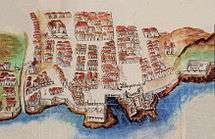
_.jpg)
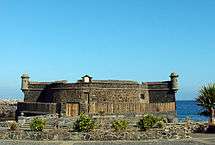
The area on which now stands the city and the municipality of Santa Cruz de Tenerife has been the subject of human occupation since the time of the Guanches, approximately 2000 years ago, as attested by the archaeological sites found. The area was known to the Guanches, the first inhabitants of the island, as Añazo. The famous Mummy of San Andrés is one of the most important archaeological remains of the aboriginal past of the region. Besides caves with some remains of mummified animals and stones with engravings ruprestres. This area belonged to the Menceyato de Anaga (aboriginal Guanche kingdom of Anaga), one of nine in which the island was divided.
Later, it became one of the most important ports of the Atlantic and the Canary Islands, a status it retains to this day. This former fishermen's village rose to prominence after a Volcano destroyed the port of Garachico in the 18th century. Santa Cruz became the major port on the Island. It first won its independence from La Laguna and, in the 19th century, was awarded the status of Capital of the Canary Islands province by King Ferdinand VII.
Between 1833 and 1927 Santa Cruz de Tenerife was the sole capital of the Canary Islands. In 1927 a Royal decree ordered that the status of capital city of the Canary Islands would be shared with Las Palmas in Gran Canaria. This arrangement remains in place today.[6][7]
In recent years, it has become clear that there exists a de facto union with neighbouring city San Cristóbal de La Laguna (141,627 inhabitants as in 2005 census) due to the rapid population growth and reduction in undeveloped space between the cities, as their suburbs merged, forming a metropolitan area with 420,198 inhabitants (including the nearby municipalities of Tegueste, Candelaria and El Rosario). Regarding this situation, the mayor of Santa Cruz, Miguel Zerolo Aguilar and his La Laguna counterpart, Ana María Oramas Moro, both belonging to the Canarian Coalition, stated several times to local media that they shared a willingness to proceed to a full political union between their municipalities, even though the decision was postponed to a date after the local elections in 2007. As of 2012 the merger is no longer part of the political agenda. [13]
Administrative divisions
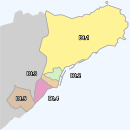
Santa Cruz is divided administratively into five districts, which in turn are subdivided into districts, not necessarily consistent with the traditional neighborhoods.
| No | District | Population[14] |
|---|---|---|
| 1 | Anaga | 14.135 |
| 2 | Centro-Ifara | 53.652 |
| 3 | La Salud-La Salle | 70.120 |
| 4 | Ofra-Costa Sur | 47.977 |
| 5 | Distrito Suroeste | 41.136 |
Demographics
In 1990, the population peaked above the 200,000 mark. Santa Cruz de Tenerife and the city of San Cristóbal de La Laguna form a continuous urban area, with a combined population of over 380,000 inhabitants.[15][16]
Ethnically, the population is mainly from the Spanish Peninsula, primarily from Málaga and Granada, with some mix of the island's original inhabitants, the Guanches. There has been some Latin American immigration (especially from Cuba and Venezuela) as well as from both Northern and Sub-Sahara Africa. There are also important historical minorities such as Indians (Sindhi), Koreans (see Koreans in Spain) and, more recently, Russians. The majority of the population professes the Catholic religion, but there are also small communities of Hindus and Muslims. In Santa Cruz de Tenerife, crime has decreased in recent years and the city has gained a reputation for tolerance among its inhabitants. In fact, Santa Cruz de Tenerife was the first city of the Canary Islands to display the rainbow flag alongside the flag of the City Council, in June 2008.[17]

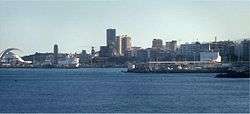
| Year | Population |
|---|---|
| 1991 | 200,172 |
| 1996 | 203,787 |
| 2001 | 188,477 |
| 2002 | 217,414 |
| 2003 | 220,022 |
| 2004 | 219,466 |
| 2006 | 221,956 |
| 2007 | 220,902 |
| 2008 | 226,232 |
| 2013 | 206,593 |
Metropolitan area
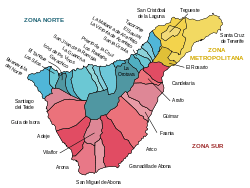
The Santa Cruz de Tenerife-La Laguna Metropolitan Area forms the second largest city and metropolitan area of the European Union outside Europe. According to data provided by the Canary Islands Government and Cabildo de Tenerife the metropolitan area of Santa Cruz de Tenerife is composed of the municipalities of Santa Cruz de Tenerife, San Cristobal de La Laguna, El Rosario and Tegueste with a population of 404,913 inhabitants in 2008, 322.13 km2, and a population density of 1,156.33 inhabitants/km2.[18]
According to AUDES5 this conurbation also comprises the municipalities of Tacoronte and El Sauzal, bringing the total population of the urban population would reach 581.947 (2008).[19]
The cities of Santa Cruz and San Cristobal de La Laguna and urban are physically linked, so that together have a population of over 382,331 inhabitants, making them the largest urban area in the Canaries (independent of municipal lines).[15][16][20]
Infrastructure

As the centre of the Tenerife Metropolitan Area, Santa Cruz is the hub for the island's motorway network. The 85 km. long Autopista TF-1 links the south of the island, including Playa de las Américas and other southern resorts and towns, with its capital. The motorway itself starts near the Auditorio and gives access to Santa Cruz and La Laguna by three different routes.
Autopista TF-5 links Santa Cruz with the Puerto de la Cruz, La Orotava and the northern side of the island, passing right through La Laguna before entering Santa Cruz.
The Santa Cruz harbour is one of the busiest in Spain; three quays host regular ferries, fast ferries, cruise ships and merchant ships.
Tenerife North Airport, formerly Los Rodeos Airport, is adjacent to Autopista TF-5 on the western outskirts of the city.
The mostly tourist Tenerife South Airport, formerly Reina Sofia Airport, ranks 7th in Spain and is located next to the Autopista TF-1, 75 km. south of Santa Cruz. There are plans to link this airport to the capital with a railway network.
The Intercambiador public transport/mass transit terminal is in the Avenida 3 de Mayo, and is the hub for all TITSA bus lines, the new Tenerife Tram service, and is a major car-parking area.
The first tram line (opened in 2007) line 1, starts at the Intercambiador, and ends at La Laguna's Avenida Trinidad, with a planned extension to Tenerife North Airport A second line between La Cuesta and Tíncer opened in 2009 (connecting with Line 1 at Hospital Universitario and El Cardonal). Main article Tenerife Tram.
The area of Cabo-Llanos (south of downtown) is the location for the new expansion of the city. This place is undergoing a major boom builder who has been nicknamed "Manhattanization", where are tall, modern buildings and street layout imitates American cities.
Economy
The economy of Santa Cruz relies mainly on services. Trade, tourism, import-export, the seaport and the presence of the major political and financial institutions, as well as the most important companies, guarantee a strong economic activity and development. The building sector is important, while industry, apart from the oil refinery and food processing, is relatively minor. Santa Cruz has regenerated many areas of the city and modernised its infrastructure, built brand new areas, malls, high buildings and some charismatic structures, such as Calatrava's Auditorio or the Congress Hall, César Manrique's Marina and the not-yet-completed Óscar Domínguez Museum of Modern Art and Culture (IODACC) and the new Plaza de España layout, both by Basel-based Pritzker Prize winner studio Herzog & de Meuron. Work to renew the man-made Las Teresitas Beach is ongoing under the direction of French architect Dominique Perrault.
Cultural areas

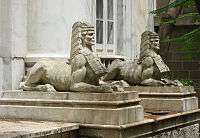

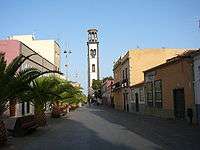
- Auditorio de Tenerife: the work of Spanish architect Santiago Calatrava. Is an emblematic building of Spanish architecture. The Tenerife Auditorium stands northeast of the Marine Park. Their great sailing boat simulating has become a symbol of the city, island and archipelago.[21] The auditorium has two rooms and a chamber symphony. It is the seat of Orquesta Sinfónica de Tenerife and it holds, among other acts, the Festival de Ópera de Tenerife, the Classical Music Festival of the Canary Islands, the Tenerife International Film Music Festival and the delivery of awards Cadena Dial.
- Guimerá Theater: Opened on 25 July 1851. Great 19th century building located in the central street of Angel Guimerá, is the oldest theater in the Canary Islands.[22]
- Museum of Fine Arts: This museum has, in addition to a fund with a deposit of works from the Prado Museum. Outstanding paintings by artists such as Peter Coeck, Ribera, Madrazo and Sorolla. As a fixed background, artists such as canaries Gaspar de Quevedo, Cristóbal Hernández de Quintana, and Juan Miranda González Méndez, among others.
- Museum of Nature and Man: history, through pictures and objects, the Guanches. There is a room where is the formation of the Canary Islands. Among the archaeological finds shown are several Guanche mummies, including two mummified fetuses. There are a lot of Guanche skulls and reproductions of works of Africa and the pre-Columbian America among many other samples. It is a museum of international reputation since it has participated in international meetings on archeology.
- Circulo de Bellas Artes: Founded in 1926 and based in Castle Street 43, is a cultural center that program of events, such as art exhibitions of painting and photography in the courtroom on the ground floor, directly accessible from the street. It has a cafeteria on the first floor.
- Espacio Cultural El Tanque: In 1997 a former container tank at the refinery, there becomes exhibitions, dance and audio, alternative music, theater, classical music, new technologies and multimedia, among other productions.
- Centro de Fotografía Isla de Tenerife: It has areas suitable for exhibition and study of traditional and contemporary photography.
- The Art Room Recova: The Recova the Art Room is located in the old market town. Do not have a permanent collection, but are rotating exhibitions throughout the year.
- TEA – Tenerife Espacio de las Artes: work of Herzog & de Meuron opened in 2008.
Urban sculptures
The city contains many pieces of sculpture, visible both in their places in their walks, so out of the fertility or Parque Garcia Sanabria Arbórea statue recalls a Sabina twisted by the wind.
But surely the whole of the Exhibition of Outdoor Sculpture in Santa Cruz de Tenerife is the most important. Situated along the Ramblas and the Parque Garcia Sanabria, and contains works by artists such as Henry Moore, Andreu Alfaro, Martin Chirino, Joan Miró and Óscar Domínguez, among others.
-

Sol rojo by Edgar Neget
-

Homenaje a Millares by Claude Viseux
-

Sin titulo by Federico Assler
-

Monumento al Gato by Óscar Domíngez
-

Femme Bouteille by Joan Miró
-

Sin titulo by Andreu Alfaro
Cultural events
- Festival de Música Clásica de Canarias.
- Festival de Ópera de Tenerife.
- Tenerife International Film Music Festival
- Festival de Zarzuela de Canarias.
- Festival Santa Blues de Tenerife.
- Plátano Rock Festival.
- MUMES. Mestizo Music Festival.
- Festival de Salsa del Atlántico.
- Carnaval
- Día de la Cruz
- Rock Coast Festival
- Premios Cadena Dial
Nightlife

Santa Cruz has not been characterized by an intense night life, in contrast to the nearby university town of La Laguna. Nevertheless, there are several clubs and pubs spread across the city. The best known are in the Parque Marítimo César Manrique, 3 May Avenue and back, and in La Noria street Residencial Anaga. Moreover, in the area of Industrial Mayorazgo, three new clubs have opened. There are also pubs that have survived without belonging to a particular location for leisure, as the platform, near the Bullring, which opened its doors in 1991.
It has recently gained importance as a leisure street Antonio Dominguez Alfonso (popularly known as Calle La Noria) and adjacent in the vicinity of the Church of the Conception. After several years of neglect, all the houses in this area has been recovered by the local hotel as tapas, light dinner and drinks. This street also hosts the headquarters of several murgas, music groups linked to Carnival, and independent organ of Events and Recreation.
Popularly known as the Avenida de Anaga (as known to all roads adjacent to the port) is in his section of Avenida Francisco la Roche a classic dinner and drinks first. During the 90s was the nerve center of nightlife, the best known local focus of the city. Although many of them closed down because of licenses and noise, attempt to regain its glory today. To that end, the City will undertake various initiatives through 2009.
In 2007, as decided by the City Council and managed by the Society for Development, is set in motion an ambitious plan for revitalization of the city under the brand name "Santa Cruz + Viva ', in accordance with Cabildo Insular de Tenerife and Government of the Canary Islands.[23]
Media
In Santa Cruz de Tenerife have drafted the three provincial newspapers (The Day, Diario de Avisos, La Opinión de Tenerife and El Día), as well as editors of newspapers regional La Gaceta de Canarias. Also located in the city the headquarters of various TV channels, most of which broadcast on the island: Spanish Television in the Canary Islands, Television Canaria, Antena 3 TV Canary Islands, Television Day, Canal 7 Atlantic, Channel 4 Tenerife, Channel 8, etc. Most radio stations are also located in the city. Radio Club Tenerife (Cadena SER), RNE, Teide Radio-Onda Cero, Radio Day, Radio ECCA etc.. In the city is the headquarters of the TV Canaria.
Tourist sites
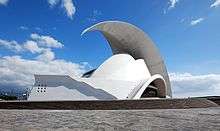
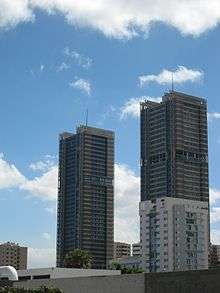
- Auditorio de Tenerife (Auditorium of Tenerife): Designed by Santiago Calatrava, the Auditorium of Tenerife was constructed in 2003. The building has an organic and famous structure in the shape of 'sails' with white blue rollers. The auditorium has a big room for concerts, a room for opera and other smaller rooms. It is an emblem of the city and is one of the more photographed buildings. This building is in the Port of Santa Cruz de Tenerife close to the sea. It was inaugurated on 26 September 2003 with the presence of Felipe de Borbón, Prince of Asturias, and was also visited by former U.S. President Bill Clinton. The profile of the famous and majestic auditorium has become a symbol of the city of Santa Cruz de Tenerife. It is one of the main attractions of Tenerife and the Canary Islands.
- Torres de Santa Cruz (Towers of Santa Cruz): Twin towers finished in 2006 are the highest skyscrapers of the city and the Canary Islands, was the tallest residential building in Spain until 2010. The Torres de Santa Cruz are also the tallest twin towers in Spain.
- Plaza de España (Spain Square): is the largest square in the city of Santa Cruz de Tenerife and the Canary Islands. The square is located in the center of town, just meters north of the Auditorio de Tenerife. It is the heart of the city, stands the great artificial lake source or work of Swiss architects Herzog & de Meuron.
- Tenerife Espacio de las Artes (Tenerife Space of Arts – TEA): Building designed by the Swiss firm of architects Herzog & de Meuron and directed by the Canary architect Virgilio Gutierrez Herreros. The building houses the contemporary museum Óscar Domínguez Institute, the Alejandro Cioranescu Island Library and the Center for Photography Island of Tenerife. In addition, the property has a hall, a restaurant, a shop, a public plaza, offices.
- Parque García Sanabria: is a public urban park in the heart of Santa Cruz de Tenerife, it was inaugurated in 1926. It is a large garden area, combined with fountains and architectural groups. It is the largest urban park in the Canary Islands. It has an area of 67,230 m2 (723,658 sq ft).
- Centro Internacional de Ferias y Congresos de Tenerife (Tenerife International Centre for Trade Fairs and Congresses): The complex was designed by architect and engineer Santiago Calatrava is configured as a multipurpose building that can host major fairs, exhibitions and conferences that take place on the island of Tenerife. The Great Hall, located on the top floor, took a total of 12,000 square meters, making it the largest covered space in the Canary Islands.
- Playa de Las Teresitas: is a beach in the village of San Andrés municipality of Santa Cruz de Tenerife. It is one of the most important beaches of the Tenerife and the Canary Islands.
- Museo de la Naturaleza y el Hombre (Museum of Nature and Man) is a museum of archeology and biology that has participated in international meetings on archeology, but his fame is mainly due to its formidable collection of Guanche mummies. For this reason, the Museum of Nature and Man is a world reference in regard to preservation of mummies.[24]
Naval history
Due to the strategic location of Tenerife on the route between the Mediterranean and the Americas, it was attacked a number of times by the English and the Dutch. In particular, Santa Cruz Bay was the scene of two notable naval engagements involving two of the most famous British admirals.
In 1656, Admiral Robert Blake totally destroyed a Spanish silver fleet of 16 ships for the loss of none of his own, despite being under fire from shore batteries and attacking and withdrawing on the tide. 50 years later, the British under John Jennings were defeated when they attacked the island on 6 November 1706 during the War of the Spanish Succession.
In 1797 Admiral Horatio Nelson met with bloody defeat in an attempt to storm the harbour. It was at this battle that Nelson lost his right arm having been hit before he had stepped off the ship's boat. It was on Santiago's day and that is the reason for having Santiago's sword cutting the lion's head as a symbol of the British defeat.
Symbols of Santa Cruz de Tenerife
Seal

The seal of Santa Cruz de Tenerife has the characteristic features of the Loyal, Noble, Invicta and very beneficial Town, Port and Plaza de Santa Cruz de Santiago de Tenerife. Curiously, it is not square or shield-shaped, but oval. In a blue background with anchors and castles have a green cross, the symbol of the Foundation Cross, which gave the city its name. Behind the cross is a sword of Santiago in red, reminiscent of the day in which the city of Santiago defeated Horatio Nelson. Under this sword are three lion heads facing right (the shield), which symbolizes the victories of the city over Nelson's English privateers, Blake and Jennings. It has castles, anchors and an island of silver. Also holds the Medal of Charity and the Crown. The crown of laurel and olive trees surrounding the shield is the symbol of victory for the city to each and every one of the attacks.
Flag
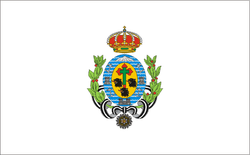
The flag of Santa Cruz de Tenerife is all white with the municipal shield in the center. Granted by Royal Warrant of King Charles IV of 28 August 1803. On a white cloth, coat of arms of the city. The white, the characteristic of the Bourbon dynasty, refers to fidelity to the city of Santa Cruz de Tenerife in the Royal House of Spain.
Port of Santa Cruz de Tenerife
The Port of Santa Cruz de Tenerife is a fishing port, commercial, passenger and sports from the city of Santa Cruz de Tenerife, capital of the island, located in the Atlantic Ocean. It is managed by the Port Authority of Santa Cruz de Tenerife.
It is the first fishing port in the Canary Islands with approximately 7,500 tons of fish caught, according to the Statistical Yearbook of the State Ports 2006 (the latest of which is changing). Following this report is the largest port number of passengers recorded.
Climate
Santa Cruz has a tropical semi-arid climate, with warm dry summers and moderately warm winters. Its average annual temperature is 25 °C (77 °F) during the day and 18 °C (64 °F) at night. In the coolest month – January, the typical day temperature ranges from 18–23 °C (64–73 °F), to around 15 °C (59 °F) at night, the average sea temperature is 20 °C (68 °F). In the warmest month, August, the typical day temperature ranges from 26–32 °C (79–90 °F), to above 21 °C (70 °F) at night, whilst the average sea temperature is 23 °C (73 °F).
Sunshine hours average at 2,887 per year, from 168 in December and to 337 in July and August.[25] Precipitation per year is only 226 millimetres (8.9 in), concentrated heavily between November and March: May to September are normally mostly dry.[26] Precipitation patterns closely resemble those of the mediterranean climates found in mainland Spain, but generally with less precipitation during winter months. The coastal regions have a climate that is comparable to coastal South California in temperature range and variation, as well as annual precipitation levels and rainfall distribution.
| Climate data for Santa Cruz (1981–2010) | |||||||||||||
|---|---|---|---|---|---|---|---|---|---|---|---|---|---|
| Month | Jan | Feb | Mar | Apr | May | Jun | Jul | Aug | Sep | Oct | Nov | Dec | Year |
| Record high °C (°F) | 28.4 (83.1) |
31.2 (88.2) |
35.4 (95.7) |
35.2 (95.4) |
36.4 (97.5) |
37.1 (98.8) |
42.6 (108.7) |
40.4 (104.7) |
39.3 (102.7) |
38.1 (100.6) |
34.0 (93.2) |
28.2 (82.8) |
42.6 (108.7) |
| Average high °C (°F) | 21.0 (69.8) |
21.2 (70.2) |
22.1 (71.8) |
22.7 (72.9) |
24.1 (75.4) |
26.2 (79.2) |
28.7 (83.7) |
29.0 (84.2) |
28.1 (82.6) |
26.3 (79.3) |
24.1 (75.4) |
22.1 (71.8) |
24.6 (76.3) |
| Daily mean °C (°F) | 18.2 (64.8) |
18.3 (64.9) |
19.0 (66.2) |
19.7 (67.5) |
21.0 (69.8) |
22.9 (73.2) |
25.0 (77) |
25.5 (77.9) |
24.9 (76.8) |
23.4 (74.1) |
21.3 (70.3) |
19.4 (66.9) |
21.5 (70.7) |
| Average low °C (°F) | 15.4 (59.7) |
15.3 (59.5) |
15.9 (60.6) |
16.5 (61.7) |
17.8 (64) |
19.5 (67.1) |
21.2 (70.2) |
21.9 (71.4) |
21.7 (71.1) |
20.3 (68.5) |
18.4 (65.1) |
16.6 (61.9) |
18.4 (65.1) |
| Record low °C (°F) | 9.4 (48.9) |
8.1 (46.6) |
9.5 (49.1) |
9.7 (49.5) |
12 (54) |
13.4 (56.1) |
16.5 (61.7) |
17 (63) |
16.8 (62.2) |
14.6 (58.3) |
10.1 (50.2) |
10 (50) |
8.1 (46.6) |
| Average rainfall mm (inches) | 31.5 (1.24) |
35.4 (1.394) |
37.8 (1.488) |
11.6 (0.457) |
3.6 (0.142) |
0.9 (0.035) |
0.1 (0.004) |
2.0 (0.079) |
6.8 (0.268) |
18.7 (0.736) |
34.1 (1.343) |
43.2 (1.701) |
225.7 (8.887) |
| Average rainy days (≥ 1.0 mm) | 8.0 | 7.2 | 6.9 | 5.5 | 2.9 | 0.9 | 0.2 | 0.8 | 2.7 | 6.1 | 8.8 | 9.4 | 59.4 |
| Average relative humidity (%) (daily average) | 64 | 63 | 62 | 61 | 61 | 61 | 58 | 61 | 65 | 65 | 64 | 67 | 63 |
| Mean monthly sunshine hours | 178 | 186 | 221 | 237 | 282 | 306 | 337 | 319 | 253 | 222 | 178 | 168 | 2,887 |
| Source #1: Agencia Estatal de Meteorología[27] | |||||||||||||
| Source #2: [28] and[29] | |||||||||||||
| Jan | Feb | Mar | Apr | May | Jun | Jul | Aug | Sep | Oct | Nov | Dec | Year |
|---|---|---|---|---|---|---|---|---|---|---|---|---|
| 20.1 °C (68.2 °F) | 19.4 °C (66.9 °F) | 19.3 °C (66.7 °F) | 19.5 °C (67.1 °F) | 20.1 °C (68.2 °F) | 21.1 °C (70.0 °F) | 22.0 °C (71.6 °F) | 22.8 °C (73.0 °F) | 23.7 °C (74.7 °F) | 23.6 °C (74.5 °F) | 22.3 °C (72.1 °F) | 20.8 °C (69.4 °F) | 21.3 °C (70.3 °F) |
Carnival
During the Carnival of Santa Cruz de Tenerife, thousands of people take to the streets each year for over a week. On 18 January 1980 it was declared a Fiestas of International Tourist Interest by the Secretary of State for Tourism, and is one of the world's largest carnivals.[31][32] At present, the Carnival of Santa Cruz hopes to become a World Heritage Site.[9]
Sites of interest
Attractions
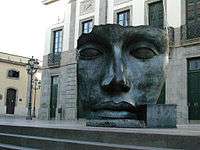
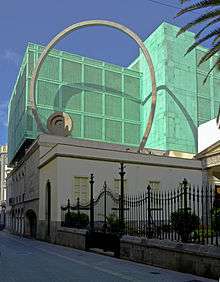
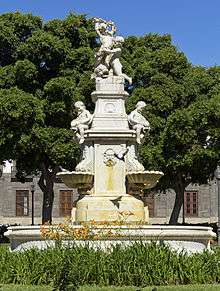
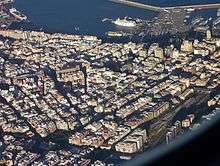
- Calle de la Noria
- Macizo de Anaga
- Igueste de San Andrés
- Taganana
- San Andrés
- Palmetum of Santa Cruz de Tenerife
- Museo de la Naturaleza y el Hombre
- Parque Marítimo César Manrique
- Playa de Las Teresitas
- Auditorio de Tenerife
- Teatro Guimerá
- Museo Municipal de Bellas Artes de Santa Cruz de Tenerife
Skyscrapers
- Torres de Santa Cruz
- Rascacielos de la avenida Tres de Mayo
- Edificio Olimpo
- Edificio Juan Amador
Parks and squares
- Parque García Sanabria
- Parque de La Granja
- Plaza de 25 de julio (de los Patos)
- Plaza de España
- Plaza de la Candelaria
- Plaza del Príncipe
- Plaza de Weyler
- Plaza del Chicharro
Churches and historical monuments
- Iglesia de La Concepción (church)
- Iglesia de San Francisco de Asís (church)
- Iglesia de Nuestra Señora del Pilar (church)
- Iglesia de San José (church)
- Cabildo Insular de Tenerife (governing body of the island)
- Castillo de San Juan Bautista or Castllo Negro (castle)
- Castillo de San Cristóbal (castle)
- Castillo de San Andrés (castle)
- Parlamento de Canarias (Parliament of the Canary Islands)
- Masonic Temple of Santa Cruz de Tenerife
Commercial areas
Santa Cruz is popular for its wide commercial offerings, including zona Centro (Central part) – Pedestrian calle Castillo, San José, del Pilar, Viera y Clavijo Zona Rambla (Rambla area) or Rambla de Pulido, calle Ramón y Cajal, and the big shopping centres and department stores in Avenida de 3 Mayo, plus the big malls in Añaza on the southern suburbs. The most upmarket and high street shopping is located along Calle del Pilar and nearby Parque Bulevar Shopping Centre, where many designer shops can be found. International and local brands of shops and restaurants, such as Zara, Mango, H&M, El Corte Inglés, Ikea, C&A, McDonalds and Burger King are much present on the island. Not only the wide range of shops makes the city attractive but the lower prices found in many items, such as tobacco, alcohol, electronic devices, beauty products, sunglasses or even food or coffee. They are indeed much lower than in most cities of Western Europe including Spain, due to the very special and much lighter taxation on goods enjoyed on the Canary Islands.
Sports

- CD Tenerife: Founded in 1922, it currently plays in Segunda División, holding home matches at the Estadio Heliodoro Rodríguez López, with a 21,732-seat capacity.
Honours: In 1991, Argentine Jorge Valdano took charge of the club as manager, and would help rob former side Real Madrid of two consecutive league titles in the last round, to the benefit of FC Barcelona; in the first season, the Canary Islands outfit barely avoided relegation, but would finish in a best-ever fifth position in the following year, eventually reaching the round of 16 in the subsequent UEFA Cup, losing to Juventus FC 2–4 on aggregate. CF Tenerife has finished in fifth position in La Liga on two occasions, in 1992/93 and 1995/96. It is the only Canary team that has played a European competition.
- CV Tenerife: Volleyball is one of the island's most successful sports, particularly in women's volleyball where CV Tenerife were European champions and participate in the Spanish Super League.[9] Two other teams are the women's CV Aguere 2009/2010 Super League champions[10] and the men's Arona Playa de las Américas which competes in the Spanish Super League. There is a growing interest in this sport in Tenerife.
- Isla Tenerife Canarias: is a professional basketball team based in San Cristóbal de La Laguna, Tenerife, Canary Islands, and plays in the Pabellón Insular Santiago Martín, in Liga ACB league.
Education
International schools:
- Lycée Français de Tenerife "Jules Verne" (French school)
- Deutsche Schule Santa Cruz de Tenerife (German school) in nearby El Rosario[33]
- Svenska Skolan Teneriffa (Swedish school) in nearby Arona[34]
- British School of Tenerife with campuses in La Orotava, Los Realejos, and Puerto de la Cruz[35]
- Wingate School (British school) in Arona[36]
Celebrations of the city
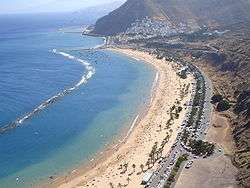
- 27 January anniversary of the appointment of Santa Cruz de Tenerife of the Canary Islands as the capital.
- February, Carnival (of International Tourist Interest).
- May 3, May festivities. Día de la Cruz (Day of the City of Santa Cruz de Tenerife).
- 25 July, the day of Saint James the Great (patron saint of Santa Cruz de Tenerife) and defeat of Admiral Nelson.
Consulates
The consulates located in Santa Cruz de Tenerife are:
- Austria
- Argentina
- Belgium
- Bolivia
- Brazil
- Chile
- Colombia
- Costa Rica
- Denmark
- Ecuador
- Philippines
- Finland
- France
- United Kingdom
- Germany
- Guatemala
- Honduras
- India
- Ireland
- Italy
- Liberia
- México
- Monaco
- Nicaragua
- Norway
- Netherlands
- Perú
- Portugal
- Sri Lanka
- Sweden
- Turkey
- Uruguay
- Venezuela
International relations
Twin towns – Sister cities
Santa Cruz de Tenerife is twinned with:
|
|
Santacruceros
- Juan de Abreu, painter and sculptor
- Víctor Añino Bermúdez, footballer
- Carlos Armas, singer
- Rafael Arozarena, writer
- Antonio Betancor, film director
- Caco Senante, singer
- Pedro Rodríguez Ledesma, footballer
- Alberto Vázquez-Figueroa, writer
In popular culture
- In 2015, the fifth part of the movie "The Bourne Identity" was filmed in this city. To do this, the city of Santa Cruz de Tenerife was especially set to simulate the Greek cities of Athens and Piraeus. The Plaza de España which is the main square of city of Santa Cruz, was set to represent Syntagma Square.[39]
See also
References
- ↑ El nuevo perfil de Santa Cruz de Tenerife con el Auditorio
- ↑ Instituto Canario de Estadística, area
- 1 2 Instituto Canario de Estadística, population
- 1 2 Demographia: World Urban Areas – Demographia, 2015
- ↑ Eurostat. "Population and living conditions in Urban Audit cities, larger urban zone (LUZ)".
- 1 2 Real Decreto de 30 de noviembre de 1833 on wikisource
- 1 2 Real Decreto de 30 de noviembre de 1833 at the official website of the Canary Islands Government
- ↑ "Turismo Tenerife: Alojamiento, Carnaval, Actividades... – Tenerife". Retrieved 25 May 2015.
- 1 2
- ↑ "Spain Skyscraper Diagram". Skyscraperpage.com. Retrieved 2011-04-13.
- ↑ "Santa Cruz de Tenerife, uno de los cinco mejores sitios del mundo para vivir, según "The Guardian"". ABC.es. Retrieved 25 May 2015.
- ↑ "El por qué de Santa Cruz de Santiago de Tenerife Santa Cruz de Tenerife – Portal turismo y ocio de Santa Cruz de Tenerife Islas Canarias – SANTACRUZ MAS +++++++++". Retrieved 25 May 2015.
- ↑
- ↑ Instituto Nacional de Estadística (Spain) – Datos Poblacionales del término municipal de Santa Cruz de Tenerife. Avance del Padrón Municipal. Datos provisionales. , 1 January 2007
- 1 2 "Dos ciudades, una Isla y un millón de opciones" (PDF). Retrieved 2011-04-13.
- 1 2 http://www.webtenerife.com/PortalTenerife/Home/Disfruta+sin+perderte+nada/Informacion+practica/Antes+de+viajar/Zonas+turisticas/SANTA+CRUZ-LA+LAGUNA.htm Santa Cruz-La Laguna
- ↑ "Santa Cruz celebra que los LGTB "pueden amar sin ser condenados a pena de muerte"". Ecodiario.eleconomista.es. 28 June 2008. Retrieved 2011-04-13.
- ↑ Cabildo de Tenerife. "Estudio del área metropolitana" (in Spanish).
- ↑ AUDES5. "Población de las areas metropolitanas" (in Spanish).
- ↑ "La sala de máquinas del nuevo Santa Cruz". Eldia.es. Retrieved 2011-04-13.
- ↑ "AUDITORIO DE TENERIFE "ADáN MARTíN" – Centros de congresos – Página oficial de Turismo de Tenerife". Webtenerife.com. Retrieved 2011-04-13.
- ↑ TEATRO GUIMERÁ – Teatro, danza y música en Santa Cruz de Tenerife Archived 23 June 2008 at the Wayback Machine
- ↑ "Santa Cruz de Tenerife – Portal turismo y ocio de Santa Cruz de Tenerife Islas Canarias – SANTACRUZ MAS +++++++++". Retrieved 25 May 2015.
- ↑ Espacios culturales Auditorio de Tenerife. "Cultural sites in Santa Cruz de Tenerife (in Spanish)". Stacruz.es. Retrieved 2011-04-13.
- ↑ "Weather2Travel.com: Santa Cruz Climate Guide".
- ↑ "World Meteorological Organization: Weather Information for Santa Cruz".
- ↑ "Valores Climatológicos Normales. Santa Cruz De Tenerife".
- ↑ "Santa Cruz de Tenerife, Spain Travel Weather Averages (Weatherbase)". Weatherbase. Retrieved 25 May 2015.
- ↑ dsource 3 = Agencia Estatal de Meteorología"Valores Climatológicos Extremos. Santa Cruz De Tenerife". Retrieved February 2015.
- ↑ Santa Cruz de Tenerife Climate – seatemperature.org
- ↑ Noticia sobre el Carnaval en Canarias, publicada por el diario Canarias7, 7 February 2007
- ↑ <<Yoteca>> Guía de ayuda documentada,, 22 February 2008
- ↑ "Deutsche Schule Santa Cruz de Tenerife." ZfA. Retrieved on 13 February 2016. "Deutsche Schule - Colegio Alemán Calle Drago , 1 38190 Tabaiba Alta (El Rosario) Spanien"
- ↑ "Adress." Svenska Skolan Teneriffa. Retrieved on 13 February 2016. "Adress Colegio Sueco Calle Coronel 8, local 9 Los Cristianos 38650 Arona Tenerife, Espana"
- ↑ "Find Us." British School of Tenerife. Retrieved on 13 February 2016. "La Luz Carretera de La Luz S/N; 38300 La Orotava" and "TRINITY Camino Montijo, 16; 38410 Los Realejos" and "YEOWARD C/ Irlanda, 1; Parque Taoro; 38400 Puerto de la Cruz"
- ↑ "Home page." Wingate School. Retrieved on 13 February 2016. "Mirador de la Cumbrita, 10, Cabo Blanco, Arona, Tenerife, 38626"
- ↑ "The International Affairs Department (IAD)". Sanantonio.gov. Retrieved 2011-04-13.
- ↑ "Villes jumelées avec la Ville de Nice" (in French). Ville de Nice. Retrieved 2013-06-24.
- ↑ El rodaje de 'Bourne 5' convierte a la ciudad de Santa Cruz de Tenerife en Atenas
External links
| Wikimedia Commons has media related to Santa Cruz de Tenerife. |
 Santa Cruz de Tenerife travel guide from Wikivoyage
Santa Cruz de Tenerife travel guide from Wikivoyage "Santa Cruz de Tenerife". Encyclopædia Britannica (11th ed.). 1911.
"Santa Cruz de Tenerife". Encyclopædia Britannica (11th ed.). 1911.
 |
Atlantic Ocean |  | ||
| San Cristóbal de La Laguna | |
Atlantic Ocean | ||
| ||||
| | ||||
| El Rosario | Atlantic Ocean |
| ||||||||
| |||||||||||||
| ||||||||||||
| |||||||||||||||||||
|
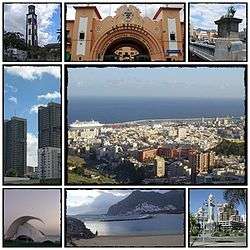



.jpg)